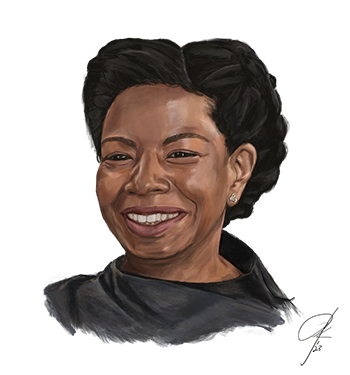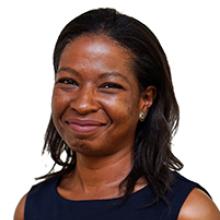Meet the Expert: Brandy Farrar

Brandy Farrar uses mixed methods to identify evidence-based best practices for health care policies and services. As a trained sociologist, she is particularly interested in the intersection between individual-level social psychology and system-level structures and processes. Her research experience spans a variety of organizational settings, including hospitals, nursing homes, government agencies, and educational institutions.
POSITION: Managing Director
AREAS OF EXPERTISE: Health policy, health equity, implementation evaluation, and human-centered design
YEARS OF EXPERIENCE: 20
Q: Much of your work touches on health equity. How has COVID-19 affected health inequities in the United States?
Brandy: COVID has pushed equity to the forefront of our national conversation. People have understood, abstractly, that there’s been inequality in our country for a long time. But the pandemic showed the public what that looks like, very viscerally, in practice. People died because they couldn’t access appropriate care, or because they couldn't understand the health information they received. This increased public awareness is bittersweet, but I think it has renewed investments in addressing these issues. Federal and state agencies are studying where and why these disparities exist, and how policy changes can promote equity, which is important and necessary work. Early in the pandemic, someone said to me, “Never let a crisis go to waste.” At the same time, we’re still witnessing stark, very sad disparities, where people of color and people with fewer financial resources experience poorer health outcomes around contracting and recovering from COVID-19.
Q: RADx-UP is an effort funded by the National Institutes of Health (NIH) to address COVID-19 health inequities. What does the project aim to do?
Brandy: Early in the pandemic, NIH sought to help reduce disparities in COVID outcomes for marginalized populations. With that goal in mind, they issued emergency grants to academic research centers across the country that were already receiving NIH grants. This allowed the NIH to distribute the money very quickly, which was essential, and to work with community-based organizations to design interventions and then evaluate them. These interventions, which assess and expand COVID-19 testing for underserved and vulnerable populations, help address the problem at hand, while also building an evidence base on health disparities. It’s a great combination.
[T]he pandemic showed the public what [inequality] looks like, very viscerally, in practice. People died because they couldn’t access appropriate care, or because they couldn't understand the health information they received.
AIR is partnering with the RADx-UP Coordination Center, which is designed to support grantees with their projects. Specifically, we’ve helped develop a data-sharing infrastructure, and we also work very closely with the teams who provide direct technical assistance to the grantees. We designed a low-burden process for systematically collecting and analyzing the challenges and successes that grantees face. We share the results of these analyses with the technical assistance teams, so that they can advise grantees who experience similar challenges, share best practices, and connect grantees to each another.
Another major body of our work centers around information dissemination. As I mentioned earlier, the public information from government agencies and scientists around COVID is very complex. We translate that information into plain language that’s culturally appropriate, easy to use, and useful.
Q: One of the main components of the project is a data visualization guide. What does it encompass, and how can it be used?
Brandy: Researchers understand their data on a deep, nuanced level, but they sometimes struggle to communicate about it with non-researchers in an accessible way. The data visualization guide helps to close that gap. It standardizes which RADx-UP results we communicate, and it shares best practices around communication. So, once grantees have done their research and want to share their results with wide audiences, this guide will help them identify user-friendly ways to graphically display their results. For example, the Equity Evidence Academy Data Profile provides grantees with a common understanding of the ways that we can improve health communication, in a navigable, accessible format.
We’re proud of this resource; it went through a lot of iterations, and we received a lot of feedback on it. Incidentally, that's something that we always recommend to people developing data visualizations—to gather input from the people who will use or consume it. We followed our own advice: people from across the coordinating center user-tested the guide.
Q: As a sociologist, you have considerable experience working with communities and using evidence. What have you learned about community capacity-building best practices?
Brandy: One fundamental lesson is: start with a shared definition of “community.” People hear very different things in that word: geographic community; a community based on shared characteristics; a community based on shared expertise or shared goals. These are all very different!
It’s also essential to work in community to build capacity. We need to amplify the voices of community members—their descriptions of their own needs and how best to address them. Sometimes as researchers, we get very committed to our frameworks and structures—but that's not how the rest of the world necessarily thinks. That’s why it’s important to step back and allow community members to drive the pace of the conversation. Sometimes that aligns with a researcher’s processes and tools, but sometimes it doesn't, and that's okay. Moving the needle requires deep community relationships, and those take time to develop.
Q: RADx-UP involves many, many stakeholders across the country. How do you facilitate the sharing of best practices among them?
Brandy: One initiative we’re particularly excited about is the Equity Evidence Academy. Twice a year, the Coordination and Data Collection Center gathers all grantees, as well as experts outside of RADx-UP, to translate and share best practices, recent experiences in the field, and lessons learned. It’s a great convening of different lenses and perspectives, and an opportunity for dialogue. In addition to presentations, there’s designated time for Q&A, as well as small group, topic-based discussions.
Similarly, with projects like the data visualization guide, we develop resources and push them out as broadly as we can. The technical assistance consultants meet monthly with their grantees. We studied those discussions—the successes and challenges that they described—and then reported the trends out as widely as possible. For a few months, I was doing nonstop presentations: to internal stakeholders, the grantees and their community partners, and the NIH.
In addition to those presentations and Q&A sessions, there is also a resource library, which aggregates tools that community members have found useful, and a Slack channel. We’re trying to reach people where they are, no matter how they prefer to communicate.
Q: Where can we find you on a typical Saturday?
Brandy: I like to run—I’ve been doing it for years. Saturdays are when I usually have time for my longest runs, preferably outside, near some natural beauty.
Q: What book would you suggest everyone read?
Brandy: I keep coming back to Atomic Habits by James Clear. It’s different from other self-help books because it focuses on creating systems and processes, rather than focusing on an end goal. It’s about the small little habits that you build daily that lead to success. As a society, we think people achieve overnight success, but when you dig into people’s stories, you realize they’ve been slowly chipping away at their work for decades.
